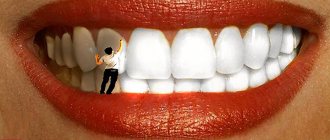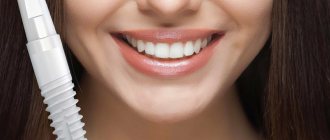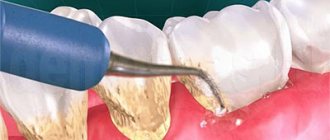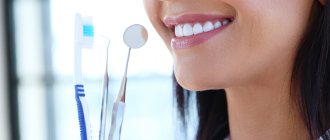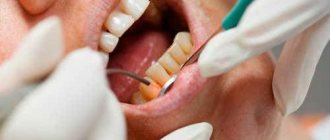What is proper oral hygiene
The goal of proper personal oral hygiene is to make your teeth healthier, your breath fresh and pleasant, and to prevent bleeding gums and the formation of yellow plaque. As a result of proper care, your smile will become attractive and snow-white, and the main result is the prevention of dental diseases.
Proper nutrition is also very important. For example, apples strengthen enamel.
There are several indicators of proper and effective oral hygiene:
- clean teeth without stuck pieces of food;
- pink gums that do not hurt or bleed when brushing;
- no bad breath;
- There is no pain when chewing food.
If the condition of your teeth does not correspond to at least one of these signs, you need to contact your dentist. If necessary, he will provide treatment and give advice on oral care, recommend suitable toothbrushes and pastes, and point out problem areas.
The importance of proper oral care
The need to take care of your oral cavity is obvious. The purpose of hygiene procedures is, first of all, the prevention of caries, periodontal disease and other diseases that can lead to tooth loss. Irregularity of procedures leads to the fact that plaque remains on the surface of the enamel, and food debris accumulates in the gaps, which rot and create a comfortable environment for the proliferation of pathogenic bacteria. As a result, bad breath appears and gum disease develops.
If plaque remains on the teeth for a long time, it mineralizes and turns into tartar, which cannot be removed at home. The stone causes deformation and thinning of tooth enamel, making it more sensitive and painful.
But proper oral hygiene is important for more than just dental health. According to doctors, there are more than 60 diseases that are directly or indirectly the result of dental problems. Among them:
- diseases of the cardiovascular system;
- rheumatism;
- digestive problems;
- kidney disease;
- skin rashes;
- nervous disorders.
Therefore, systematic and competent hygiene of teeth and gums is important for the overall health of the body.
Irrigators
The irrigator combines the modernized functions of an oral shower and a hydromassage. A stream of warm water is supplied through a tip from a tap or storage tank using a compressor. Medicinal solutions can optionally be used as a washing liquid. The processing time for one jaw is at least 5 minutes.
Irrigators are recommended for daily use at home. Critically necessary for people with orthodontic structures and a predisposition to the formation of plaque on the tongue.
General principles of good oral hygiene
The first and most important rule, which even children know, is the immutable truth that teeth should be brushed twice a day. This must be done correctly, with a specially selected brush. In addition, it is necessary to additionally clean the interdental spaces using floss.
But there are also nuances that not everyone knows:
- For dental health, it is necessary to adhere to a proper diet, avoiding snacks between main meals;
- choose toothpastes and rinses containing fluoride, which strengthens the enamel;
- after brushing your teeth and eating, use rinses that will destroy bacteria where the toothbrush cannot reach;
- Brush your teeth for at least two minutes.
Don't skimp on brushing your teeth properly. This can lead to serious problems in the future.
Professional hygiene
If the plaque has already turned into stone, only a dentist can remove it. At the same time, it is not possible to completely remove plaque even if you follow all the rules for brushing your teeth. Therefore, everyone who cares about their dental health is recommended to visit the dentist twice a year and have their teeth professionally cleaned. In advanced cases, gingivitis also forms, a painful inflammation of the gums.
What does professional oral hygiene include?
The first stage of oral care in the dental office is diagnosis and analysis of existing problems. Based on these, procedures are prescribed, which most often include cleaning plaque and stone (if necessary, with anesthesia).
Pigmented plaque is cleaned with a special Air Flow apparatus, which operates using a jet stream of aerosol containing sodium bicarbonate.
In modern dental clinics, ultrasound is used during cleaning, which removes soft and hard deposits from the enamel. In this case, the teeth are not damaged, plaque and stone are gently peeled off from visible surfaces.
The next stage is the treatment of intergingival spaces. This is a manual procedure that requires care and professionalism from the dentist.
After the stone is removed, the enamel is polished to protect it from bacteria. This is done using polishing pastes and special brushes and rubber bands.
Professional cleaning ends with the application of fluoride-containing varnish to the enamel, which provides additional protection and makes teeth less sensitive. The price of such a procedure depends on many factors, but you should not skimp on dental health.
Oral hygiene products
To effectively care for your teeth at home, you need to purchase several items. Toothpaste and a brush alone are not enough to clean the interdental space. If you neglect additional means, pathogenic bacteria and food debris will accumulate there, causing problems (including tooth loss).
Toothbrushes
You should select a toothbrush individually, taking into account several factors. First of all, this is the stiffness of the bristles and the size of the handle. The bristles are of medium hardness and are universal. Soft brushes are recommended for gum disease and bleeding, while hard brushes are recommended for very strong teeth or for dentures. The latter must be used with caution, because improper brushing with it will lead to serious damage to the gums and enamel.
The optimal length of a toothbrush handle is about 30 mm.
Effective dental care begins with choosing the right toothbrush. It is equally important to store it correctly. It is important that the brush dries quickly because moisture promotes the growth of bacteria. In addition, it is recommended to store brushes without a case.
The quality and effectiveness of teeth cleaning depends not only on the stiffness of the bristles, but also on the shape. Dentists do not have a consensus on this indicator. For example, brushes with fibers that form a V-shape clean the V-shape more effectively. Bristles of different heights remove plaque from the cervical area, as they effectively penetrate into the gingival sulcus.
The brush needs to be changed every 3 months.
Toothpastes
Another essential oral care product. Depending on the condition of the teeth, you can choose a therapeutic or prophylactic agent. Textures also vary - from gel-like to creamy. Most toothpastes contain fluoride, but its percentage varies. If you can choose a prophylactic paste yourself, based on reviews and advice from friends, then a therapeutic paste can be chosen only on the recommendations of doctors.
For one brushing of your teeth, it is not necessary to squeeze out a large amount of paste - a pea-sized volume is enough.
You should change your toothpaste every few months to ensure comprehensive oral care. Anti-bleeding agents can be alternated with strengthening and whitening agents. For example, in the morning you can use pastes against caries, and in the evening against inflammation. Before you buy baby toothpaste, study the special lines of famous brands.
Dental floss
Dental floss (or floss) is necessary to completely clean the interdental space. There are several varieties: flat, round, twisted. The threads may be coated with wax.
It is necessary to select a specific floss taking into account individual characteristics. First of all, it is worth considering the distance between the teeth. Without dental floss, comprehensive oral care is impossible; only it can completely remove food debris and prevent the proliferation of pathogenic bacteria.
Tongue cleaners
It is necessary to cleanse not only your teeth and gums of bacteria, but also your tongue. The plaque that forms on it causes bad breath and promotes the development of bacteria. To remove plaque, you can use special toothbrushes, which are equipped with a special rubber ribbed surface on the back. There are also separate tools for this procedure. It is necessary to clean the tongue by making careful movements in the direction from the base to the tip.
Rinse aids
You should use mouthwash at least twice a day, after each brushing of your teeth. It is also useful to apply them after each meal to avoid the growth of bacteria in rotting pieces of food.
Regular use of fluoride rinses for 30 seconds helps to further clean the teeth and mucous membranes. They help remove plaque, bacteria, and waste products from hidden and hard-to-reach areas of the oral cavity. These products contain various useful components, for example, purified essential oils, menthol, which reduce the concentration of microbes, protect the enamel from caries, reduce inflammation and bleeding of the gums, and remove bad breath.
Dental floss
Dental floss, or floss, is an auxiliary mechanical means for cleaning interdental spaces. A toothbrush cannot clean them, so flossing is recommended for everyone.
Dental floss is:
- cross-sectional shape - round and flat (dental bands);
- number of fibers - mono- and multi-fiber;
- the nature of surface treatment - waxed and unwaxed;
- the presence of impregnation - impregnated and unimpregnated;
- method of application - for home and professional use.
All dental floss is specially treated to increase tensile strength and is coated with a liquid paraffin mixture to reduce friction. Superflosses are 3-4 times thicker than standard hygiene products and are intended for people with wide interdental spaces - diastemas.
Waxed threads glide easier, penetrate narrow crevices, are resistant to fiber disintegration and are more convenient to use. At the same time, in terms of their cleaning characteristics, they are inferior to unwaxed ones. Most flosses are impregnated with a menthol disinfectant solution. Flosses impregnated with fluoride are also produced to strengthen enamel and prevent interdental caries.
Threads for home use are sold in sealed packages, convenient for unwinding and cutting. The floss inside is protected from contamination. One container contains 50 meters of thread.
Floss is used as follows. Pull out and cut 35–40 cm of thread, wrap its ends around the terminal phalanges of the middle fingers of both hands. Then gently and slowly insert into the interdental space, then pull and lower to the base. Repeat the movement back and forth and up and down 6-7 times. Then press the floss against the side of the tooth and move it back and forth to remove soft plaque. If you pull the floss too tightly, you can injure your gums.
How to brush your teeth correctly
To ensure proper oral hygiene, it is not enough to choose the right toothbrush, toothpaste and other products. Proper cleaning technique must be followed to completely remove plaque and tartar from the enamel surface. The basic rules of this procedure are as follows:
- making rotational movements, trying to remove food debris from the interdental space, move it from the gum to the tooth;
- Using gentle back-and-forth movements, clean the entire tooth: outer, inner and chewing surfaces. The procedure should take about 3 minutes;
- clean the surface of your tongue to freshen your breath and rid your mouth of bacteria as much as possible;
- use dental floss;
- Rinse your mouth with mouthwash for 30 seconds.
Dentists distinguish several methods of brushing teeth. The appropriate one is determined individually; it is better to consult a dentist about this. What all methods have in common is that they are performed for at least three minutes and at the same pace.
On average, instead of the allotted three minutes, people spend 46 seconds brushing their teeth.
Universal cleaning suits everyone. With it, two teeth are cleaned in turn in the direction from the gums to the cutting part of the tooth. The outer side of the teeth is cleaned first, and only then the inner side. If there are no gum diseases, you can complement the procedure with a massage using circular movements of the gums.
During standard brushing, the brush should be held at a 45-degree angle to the gum.
Brushing harshly will help remove plaque effectively, but is not suitable for people with painful gums. The brush is positioned perpendicular to the buccal surface and moves in a circle from the internal surfaces to the chewing surfaces.
Gentle brushing will not harm sensitive gums. Vertical movements from the gums down are made with the teeth closed when cleaning the front surface and with the jaw open when cleaning the inner surface.
The technique of using dental floss also implies several rules. First, the floss should be about 45 cm long. For each brushing, use a new section 3-5 cm long. The interdental spaces should be cleaned with gentle movements, following the contours of the gums. Go to the surface of the teeth below the gum line, but do it carefully, avoiding sudden movements.
Interdental brushes
These brushes are used to clean interdental spaces, teeth under removable structures, and areas between denture elements. The brush consists of a handle and a cylindrical working part with a diameter of 1.7–14 mm. To determine what individual diameter is needed, special probes are used. For people with increased enamel sensitivity, as well as for cleaning implants, brushes with soft bristles are produced.
The working part of the brush is attached to the handle with a special holder. It ensures good fixation and quick replacement. Cleaning technique - reciprocating and rotating movements in a clockwise direction. The villi have a massage effect on the gum tissue.
